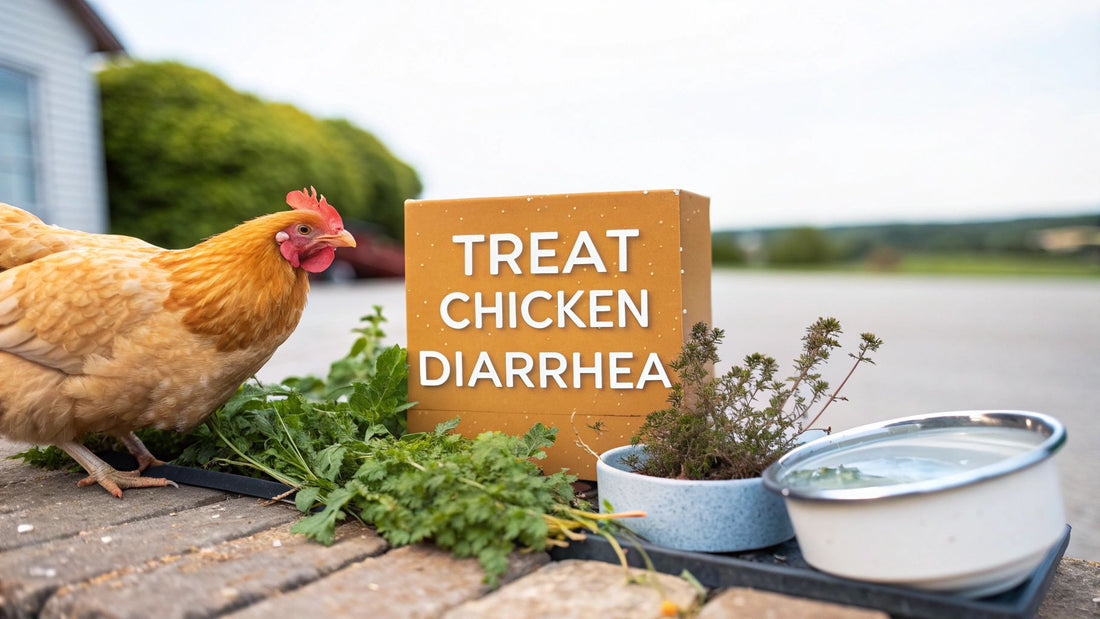
How to Treat a Chicken with Diarrhea A Practical Guide
Share
When you first spot loose droppings in the coop, it's easy to jump to conclusions. But before you start worrying, it's important to know the difference between a real problem and something perfectly normal. Not every mess is a sign of sickness.
Chickens have a unique dropping called a cecal poop, which they pass every so often. It's a normal clearing of their digestive system and usually looks like a mustardy-brown, pasty mess. Learning to tell this apart from true diarrhea is the first skill every chicken keeper needs to master.
Decoding Your Chicken's Droppings: What to Look For
To figure out what’s going on, you'll need to become a bit of a poop detective. A flock's droppings are a fantastic window into their overall health, and a sudden change in color, consistency, or frequency is your first clue that something's off.
A healthy chicken's droppings are usually firm, grayish-brown, and topped with a white "cap" of urates. Anything that deviates from this warrants a closer look.
Reading the Signs in Their Stools
The color of the droppings can tell you a lot about what’s happening inside your chicken. Different colors often point to specific health issues, ranging from a simple upset stomach to a serious infection that needs immediate attention.
- Bright Green Droppings: This one can be startling. Sometimes, it’s harmless—maybe your hen just feasted on a ton of fresh grass or leafy greens. But it can also be a warning sign for internal worms or even something more serious like Marek's disease.
- Yellow or Foamy Droppings: If you see watery, yellow, or foamy stool, it’s a red flag. This is often linked to coccidiosis (especially in younger birds) or a potential bacterial infection.
- Bloody Droppings: Finding blood is never a good sign. It's the classic symptom of coccidiosis, an intestinal parasite that can be deadly if not treated quickly. It can also indicate severe inflammation in the gut.
This infographic is a great visual reference for comparing normal droppings to those that signal a potential health problem.
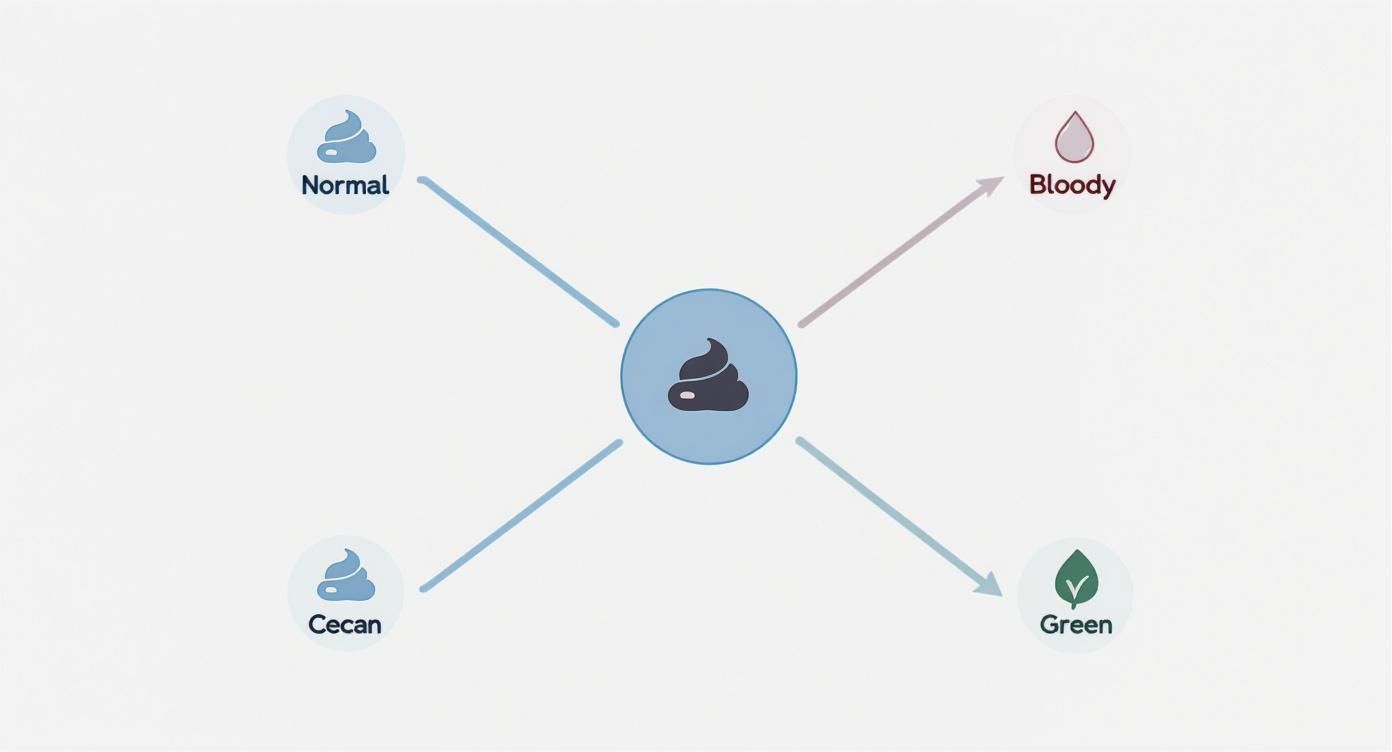
Use this guide to quickly determine if you're looking at a normal cecal dropping or something more concerning, like bloody or oddly colored stool.
Observing Other Sickness Symptoms
Diarrhea is rarely a solo act. A sick bird will almost always show other signs that something is wrong, and you need to look at the whole picture.
Chickens are masters at hiding illness—it's a survival instinct to avoid looking like an easy target for predators. That’s why you have to pay attention to even the smallest changes, like a bird that’s just a little less active or has slightly ruffled feathers.
Look beyond the poop. How is your chicken acting? A healthy bird is typically busy, curious, and alert. A sick one might show a few of these signs:
- A droopy, lethargic posture
- Ruffled or puffed-up feathers, even when it's not cold
- Loss of appetite and no interest in favorite treats
- Hiding away from the rest of the flock
- A pale comb and wattles
Putting these observations together with what you see in their droppings is the key to an accurate assessment. For a more complete checklist, our guide on the common symptoms of illness in chickens is a great resource.
Getting to the Bottom of Chicken Diarrhea
Before you can fix the problem, you have to figure out what’s causing it. Pinpointing the why behind your chicken's diarrhea is the critical first step, because a simple dietary issue needs a totally different response than a serious parasitic infection.
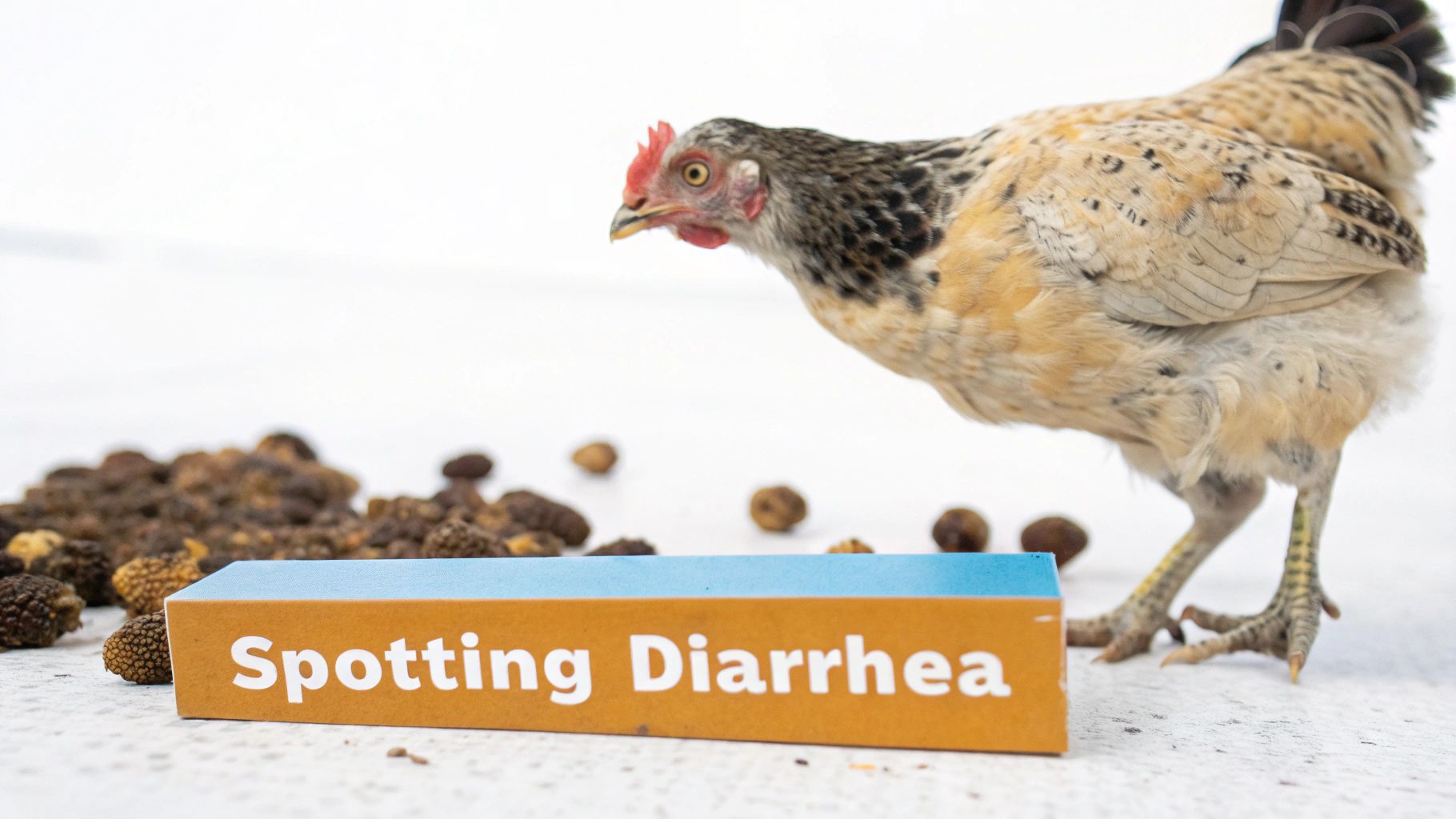
Think of yourself as a flock detective. You need to look for clues to get to the root cause. I've seen just about everything in my own coops over the years, from minor mishaps to more serious health threats. Let's break down the usual suspects.
Parasites and Infections
When diarrhea strikes, especially if it’s severe or you see blood, my mind immediately goes to parasites and bacteria. These are often the culprits behind the nastiest cases.
One of the big ones is coccidiosis. It's an intestinal parasite that's particularly rough on young chickens, usually between 4 to 10 weeks old. Coccidiosis wreaks havoc on the gut lining, causing bloody stools, and it can be deadly if you don't act fast.
Bacterial infections are also high on the list. Nasty bugs like Salmonella and E. coli can take hold if your feeders or waterers aren't clean, leading to a sudden onset of watery diarrhea that can spread through the flock like wildfire.
Poultry diarrhea is often a complex issue stemming from various factors, including coccidiosis, worms, viruses, bacterial infections, dietary mistakes, and environmental stress. While worms rarely cause diarrhea directly, they can irritate the intestines and create an opening for secondary bacterial infections. Learn more about the diverse causes of poultry diarrhea and their treatments at Poultry.care.
Diet and Environment
Thankfully, not every case of diarrhea is a five-alarm fire. Sometimes, the cause is much simpler and is sitting right in their feed dish or coop.
Have you changed their feed recently? An abrupt switch, like going straight from a starter crumble to a layer pellet without mixing them for a few days, can easily upset their digestive balance and lead to some temporary loose droppings.
Treats can be another trigger. Chickens go wild for snacks like watermelon and cucumbers, but these foods have high water content. Too much of a good thing will naturally lead to looser, watery droppings that can look a lot like diarrhea.
Stress and Other Triggers
Never discount the power of stress. A stressed-out chicken has a weakened immune system, which opens the door for all sorts of illnesses, including digestive ones.
A few common stressors to watch out for:
- Heat Stress: During a heatwave, chickens pant to stay cool and drink a ton more water. All that extra liquid has to go somewhere, resulting in very watery, often pale-colored droppings.
- Overcrowding: Too many birds crammed into one space is a recipe for stress. It creates competition for resources and allows waste to build up quickly, which is a perfect environment for disease to spread.
- New Flock Members: Bringing new birds into an established flock completely disrupts the social hierarchy—the pecking order—and causes a great deal of stress for everyone involved.
Pay close attention to your flock and their surroundings. Is it just one bird, or is the whole flock affected? Did you just introduce a new feed? Are you in the middle of a heatwave? Answering these questions will put you on the right path to finding a solution.
First Steps: Supportive Care and Hydration
When you spot a chicken with diarrhea, your first instinct might be to figure out why. But before you play detective, your immediate priority is stabilization. Diarrhea is incredibly dehydrating, and it's often the dehydration, not the initial illness, that poses the biggest threat. So, the very first thing to do is focus on supportive care.
The most critical action you can take right away is to isolate the sick chicken. This does two things: it protects the rest of your flock from anything contagious and gives your sick bird a quiet, low-stress space to recover. A calm chicken has a much better shot at healing.
Setting Up a Hospital Pen
You don’t need anything fancy for a temporary "hospital pen." A large dog crate, a sectioned-off corner of the garage, or even a big, sturdy cardboard box will do the trick. The goal is to make it comfortable and functional.
Lay down a thick, clean layer of absorbent bedding, like pine shavings. This helps manage the messy droppings and keeps your chicken dry. Make sure the pen has its own dedicated food and water, placing them where the chicken can easily get to them.
A sick chicken shouldn’t have to compete for food or water, nor should it deal with the usual pecking order politics. Simply separating it is one of the most powerful first steps you can take.
The Power of Electrolytes
For a dehydrated chicken, plain water is good, but water boosted with electrolytes is much better. Diarrhea flushes out essential minerals that are vital for nerve and muscle function. While you can certainly buy commercial poultry electrolyte powders, it’s easy and just as effective to whip up a batch from ingredients you probably already have in your kitchen.
This simple recipe can be a real lifesaver, helping to quickly rehydrate a weak bird and replenish what’s been lost. It gives them a little sugar for energy and the salts needed to restore their body's balance.
Here’s a go-to recipe I’ve used countless times.
DIY Electrolyte Solution for Chickens
A simple recipe using household ingredients to create a hydrating electrolyte solution for a sick chicken. All measurements are per quart (approx. 1 liter) of warm water.
| Ingredient | Amount | Purpose |
|---|---|---|
| Warm Water | 1 Quart | The base for hydration. |
| Sugar | 2 Tablespoons | Provides a quick source of energy. |
| Salt | ½ Teaspoon | Helps the body absorb and retain water. |
| Baking Soda | ½ Teaspoon | Replenishes lost bicarbonates and balances pH. |
Just mix everything together in warm water until it’s fully dissolved. Offer this instead of regular water for a few days. If your chicken is too weak to drink on its own, you might need to gently offer the solution from a small spoon or dropper every hour. Go slow and be careful not to force it, as you don't want the liquid to go down the wrong pipe.
Getting your chicken into a calm space and started on electrolytes gives it a solid foundation to fight off whatever is causing the trouble. Once your bird is stable and hydrated, you can start looking into the root cause and gentle remedies.
Natural Home Remedies for Digestive Health
Once your chicken is hydrated and settled in a quiet spot, you can start thinking about gentle remedies to help their system recover. In my experience, many mild cases of diarrhea clear up nicely with some natural support that restores gut balance, often without needing to jump straight to medications. These are a few of my go-to, practical options that have helped get my own birds back on their feet time and again.
My first port of call is usually probiotics. A chicken's gut is a complex ecosystem, and a bout of diarrhea can really throw it out of whack by flushing out all the good bacteria. The goal is to get those beneficial microbes back in there to do their job.
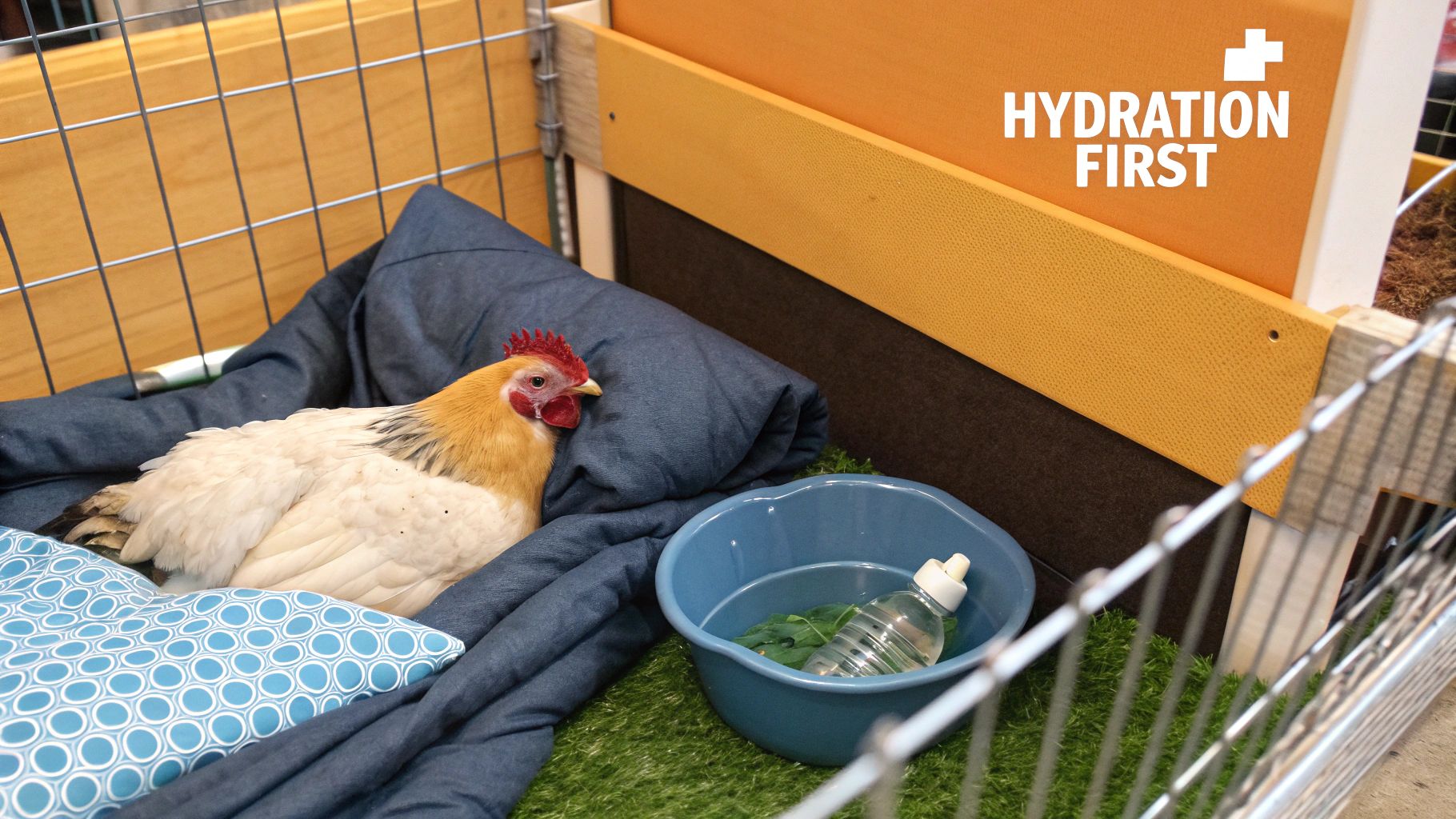
Restoring Gut Flora with Probiotics
Probiotics are essentially the "good guys" that keep the digestive system humming along. You can offer them in a couple of very simple ways.
A small spoonful of plain, unsweetened yogurt stirred into their feed is a popular and easy choice. Just make sure the label says it has "live and active cultures."
Another great option, and often a more targeted one, is to use a poultry-specific probiotic powder. You can find these at most feed stores, and they mix easily into the flock's water supply.
Pro Tip: Reintroducing good bacteria with probiotics helps rebuild a healthy gut environment. This simple step can often shorten the duration of diarrhea and bolsters the chicken's natural defenses against whatever caused the issue in the first place.
The Power of Herbs
Certain herbs are fantastic for supporting a chicken's digestive tract. Many backyard keepers, including me, have seen great results just by adding a few gentle herbs to a sick bird's diet.
- Oregano: It’s well-known for its antimicrobial properties. A light sprinkle of dried oregano in their feed or a few drops of food-grade oregano oil in their water can help knock back harmful bacteria.
- Garlic: Crushing a single fresh clove of garlic and adding it to their waterer is an old-timer trick for a gentle immune boost. Just remember to change the water out every day.
- Thyme and Sage: These are also excellent herbs with antibacterial benefits. You can offer them fresh from the garden or dried, mixed into their feed.
Always start with a small amount to see how your chicken reacts. It's a good rule of thumb for any new supplement or treat. For more ideas on safe and healthy treats, check out our guide on snacks for chickens.
You don't just have to take my word for it, either. Science is backing up what chicken keepers have known for years. One study found that an herbal blend significantly reduced diarrhea in chickens. The diarrhea score in the group given herbs was just 1.17, while the untreated group was at 3.33—a pretty dramatic difference showing how effective these natural options can be. You can read more about these herbal treatment findings on PMC.
Simple and Soothing Feed Adjustments
When a chicken's gut is upset, keeping things simple is the best approach. I recommend temporarily holding off on any rich or complex treats—like scratch grains or table scraps—and just sticking to their basic feed. This gives their digestive system a much-needed break.
To help firm up their droppings, try mixing a little plain cooked rice or a small handful of rolled oats into their feed. These bland carbs are easy to digest and do a great job of absorbing excess water in the intestines. It's amazing how these simple remedies, paired with good hydration and a stress-free environment, can turn a sick chicken around.
Building a Diarrhea Prevention Plan for Your Flock
Alright, so you've nursed your chicken back to health. That's a huge relief! Now, the real work begins: making sure it doesn't happen again. Shifting your focus from treatment to prevention is the key to a healthy, happy flock long-term. It's always easier to stop a problem before it starts than to deal with the fallout of a sick bird.
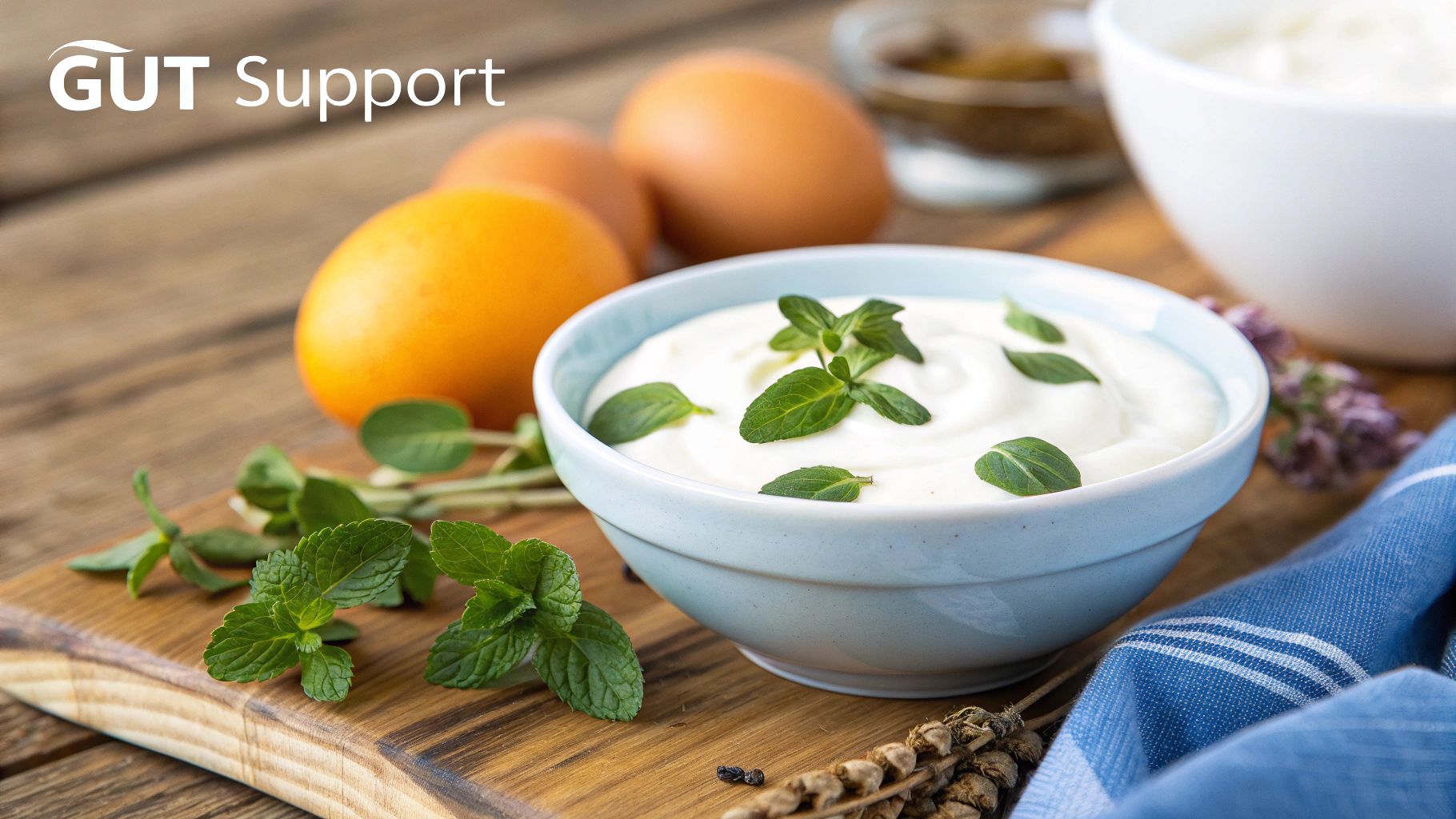
Honestly, a clean coop is your number one defense. A damp, messy coop is a five-star resort for the nasty bacteria and parasites that cause diarrhea and other gut issues. Getting into a solid cleaning rhythm is one of the most important things you can do for your birds.
Mastering Coop and Run Hygiene
Your coop doesn't need to be sterile enough for surgery, but it absolutely has to be dry. Wet bedding is a chicken keeper's nemesis. It’s not just from spilled water; accumulated droppings create moisture that releases ammonia fumes, which are terrible for a chicken's respiratory system and create the perfect breeding ground for pathogens.
A simple, effective cleaning schedule that works for most backyard keepers looks something like this:
- Daily Spot Checks: A quick daily scoop of any obvious wet spots or big poops makes a world of difference.
- Weekly Refresh: Take a rake and fluff up the bedding to aerate it. This helps it dry out. You can toss a thin new layer on top to keep things fresh.
- Seasonal Deep Clean: At least twice a year, it's time for a full reset. Shovel out all the old bedding, give the floors and walls a good scrub with a poultry-safe cleaner, and—this is crucial—let it all air-dry completely before putting in new bedding.
This consistent effort drastically cuts down on the germs your flock is exposed to. Think about it on a larger scale: farm hygiene is a critical global strategy for preventing foodborne bacteria like Campylobacter, a major cause of diarrhea in poultry. Good biosecurity and disinfection practices are proven to reduce outbreaks, and the same principle applies right in your backyard. You can learn more about how hygiene impacts poultry safety from the WHO.
Smart Biosecurity and Stress Management
"Biosecurity" might sound like a word for a big commercial farm, but it's just as important for a small flock. It really just means being smart about keeping new germs away from your birds.
The golden rule of biosecurity? Always quarantine new birds for at least 30 days before they meet the rest of your flock. This gives you plenty of time to watch for any hidden illnesses that could wipe out your established chickens.
Keeping stress levels down is another huge piece of the prevention puzzle. Chickens are creatures of habit, and things like overcrowding, sudden changes, or even wild weather can weaken their immune systems, making them vulnerable. Make sure they have plenty of space in the coop and run to avoid squabbles over food and roosting spots.
Finally, gut health starts with a consistent diet. If you need to switch feeds, don't do it overnight. Gradually mix the new feed in with the old over the course of a week to give their digestive systems time to adjust. For a complete look at what your chickens need nutritionally, our guide on what is the best food for chickens is a great resource.
By focusing on these three things—cleanliness, biosecurity, and low stress—you're building a resilient flock that is far better equipped to fight off illness.
Got Questions About Chicken Diarrhea? Let's Get Them Answered
https://www.youtube.com/embed/MXQs8P7AUUQ
When you've got a sick chicken on your hands, your mind can start racing with questions. It's completely normal to feel a bit overwhelmed—after all, you're the one in charge of keeping your flock healthy. Let's walk through some of the most common worries chicken keepers have when they spot diarrhea.
This isn't just about a checklist of treatments. It's about building your confidence so you can make the right call at the right time. A quick, smart response can make all the difference in getting your bird back on its feet.
How Long Is Too Long for Diarrhea to Last?
If your chicken got into something it shouldn't have, like a patch of super-watery garden greens, you're likely dealing with a simple dietary upset. In these cases, the diarrhea should clear up within 24 to 48 hours once you've provided clean water, a bland diet, and removed the offending "treat."
But if you’re past the two-day mark and things aren't getting better—or they're getting worse—it’s time to take it more seriously. Persistent loose droppings often signal a deeper issue, like a parasitic or bacterial infection that won't go away on its own.
As a rule of thumb, I use the 48-hour mark. If I don't see clear signs of improvement by then, I know it's time to dig deeper and move beyond simple home remedies.
When Should I Call a Veterinarian?
Most minor digestive issues can be handled right in your backyard. But some symptoms are serious enough to warrant an immediate call to a vet. Don't wait and see if you notice any of these red flags:
- Bloody Stools: This is never normal. It's a classic sign of coccidiosis or another severe internal problem.
- Extreme Lethargy: A chicken that's too weak to stand, eat, or even get to the waterer needs professional help, fast.
- Multiple Sick Birds: If one chicken gets sick, it's a concern. If it starts spreading through the flock, you're likely dealing with something contagious that needs a proper diagnosis.
- No Improvement After 48 Hours: If you've done everything right and the bird is still unwell, you've reached the limit of what you can do at home.
A vet can run a quick fecal test to pinpoint the exact cause, whether it's worms, coccidia, or a nasty bacterial infection. Guessing games waste valuable time and can lead you to use the wrong treatment entirely.
Are Eggs from a Sick Hen Safe to Eat?
I get this question all the time, and my answer is always the same: a hard no. You absolutely should not eat eggs from a hen that is visibly sick, especially one with diarrhea.
Harmful bacteria like Salmonella can be passed from an infected hen directly into the egg, long before the shell is even formed. The egg can look perfectly fine on the outside and still be contaminated. The CDC consistently tracks Salmonella outbreaks linked to backyard poultry, so this is a risk to take seriously.
Wait until your hen is fully recovered and has been her normal self for at least a week. Even then, always cook your eggs thoroughly. Your family's health and your flock's well-being always come first.
A chicken's gut health is its first line of defense. You can support their digestive system and overall wellness with a high-protein, calcium-rich treat like Pure Grubs. Our USA-grown Black Soldier Fly Larvae are a safe, natural way to keep your flock feeling strong and laying eggs with tough shells.
